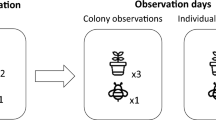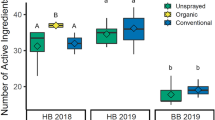Abstract
Recent concern over global pollinator declines has led to considerable research on the effects of pesticides on bees1,2,3,4,5. Although pesticides are typically not encountered at lethal levels in the field, there is growing evidence indicating that exposure to field-realistic levels can have sublethal effects on bees, affecting their foraging behaviour1,6,7, homing ability8,9 and reproductive success2,5. Bees are essential for the pollination of a wide variety of crops and the majority of wild flowering plants10,11,12, but until now research on pesticide effects has been limited to direct effects on bees themselves and not on the pollination services they provide. Here we show the first evidence to our knowledge that pesticide exposure can reduce the pollination services bumblebees deliver to apples, a crop of global economic importance. Bumblebee colonies exposed to a neonicotinoid pesticide provided lower visitation rates to apple trees and collected pollen less often. Most importantly, these pesticide-exposed colonies produced apples containing fewer seeds, demonstrating a reduced delivery of pollination services. Our results also indicate that reduced pollination service delivery is not due to pesticide-induced changes in individual bee behaviour, but most likely due to effects at the colony level. These findings show that pesticide exposure can impair the ability of bees to provide pollination services, with important implications for both the sustained delivery of stable crop yields and the functioning of natural ecosystems.
This is a preview of subscription content, access via your institution
Access options
Subscribe to this journal
Receive 51 print issues and online access
$199.00 per year
only $3.90 per issue
Buy this article
- Purchase on Springer Link
- Instant access to full article PDF
Prices may be subject to local taxes which are calculated during checkout



Similar content being viewed by others
References
Gill, R. J., Ramos-Rodriguez, O. & Raine, N. E. Combined pesticide exposure severely affects individual- and colony-level traits in bees. Nature 491, 105–108 (2012)
Whitehorn, P. R., O’Connor, S., Wäckers, F. L. & Goulson, D. Neonicotinoid pesticide reduces bumble bee colony growth and queen production. Science 336, 351–352 (2012)
Godfray, H. C. J. et al. A restatement of the natural science evidence base concerning neonicotinoid insecticides and insect pollinators. Proc. R. Soc. Lond. B 281, 20140558 (2014)
Arena, M. & Sgolastra, F. A meta-analysis comparing the sensitivity of bees to pesticides. Ecotoxicology 23, 324–334 (2014)
Rundlöf, M. et al. Seed coating with a neonicotinoid insecticide negatively affects wild bees. Nature 521, 77–80 (2015)
Feltham, H., Park, K. & Goulson, D. Field realistic doses of pesticide imidacloprid reduce bumblebee pollen foraging efficiency. Ecotoxicology 23, 317–323 (2014)
Gill, R. J. & Raine, N. E. Chronic impairment of bumblebee natural foraging behaviour induced by sublethal pesticide exposure. Funct. Ecol. 28, 1459–1471 (2014)
Henry, M. et al. A common pesticide decreases foraging success and survival in honey bees. Science 336, 348–350 (2012)
Fischer, J. et al. Neonicotinoids interfere with specific components of navigation in honeybees. PLoS One 9, e91364 (2014)
Klein, A. M. et al. Importance of pollinators in changing landscapes for world crops. Proc. R. Soc. Lond. B 274, 303–313 (2007)
Ollerton, J., Winfree, R. & Tarrant, S. How many flowering plants are pollinated by animals? Oikos 120, 321–326 (2011)
Kleijn, D. et al. Delivery of crop pollination services is an insufficient argument for wild pollinator conservation. Nat. Commun. 6, 7414 (2015)
Eilers, E. J., Kremen, C., Greenleaf, S. S., Garber, A. K. & Klein, A. M. Contribution of pollinator-mediated crops to nutrients in the human food supply. PLoS One 6, e21363 (2011)
Lautenbach, S., Seppelt, R., Liebscher, J. & Dormann, C. F. Spatial and temporal trends of global pollination benefit. PLoS One 7, e35954 (2012)
Goulson, D. An overview of the environmental risks posed by neonicotinoid insecticides. J. Appl. Ecol. 50, 977–987 (2013)
Goulson, D., Nicholls, E., Botías, C. & Rotheray, E. L. Bee declines driven by combined stress from parasites, pesticides, and lack of flowers. Science 347, 1255957 (2015)
Brittain, C. & Potts, S. G. The potential impacts of insecticides on the life-history traits of bees and the consequences for pollination. Basic Appl. Ecol. 12, 321–331 (2011)
Sheffield, C. S. Pollination, seed set and fruit quality in apple: studies with Osmia lignaria (Hymenoptera: Megachilidae) in the Annapolis Valley, Nova Scotia, Canada. J. Pollinat. Ecol . 12, 120–128 (2014)
Garratt, M. P. D. et al. Pollination deficits in UK apple orchards. J. Pollinat. Ecol. 12, 9–14 (2014)
Palmer, M. J. et al. Cholinergic pesticides cause mushroom body neuronal inactivation in honeybees. Nat. Commun. 4, 1634 (2013)
Déglise, P., Grünewald, B. & Gauthier, M. The insecticide imidacloprid is a partial agonist of the nicotinic receptor of honeybee Kenyon cells. Neurosci. Lett. 321, 13–16 (2002)
Cutler, G. C. & Rix, R. R. Can poisons stimulate bees? Appreciating the potential of hormesis in bee-pesticide research. Pest Manag. Sci. 71, 1368–1370 (2015)
Sakamoto, R. L., Morinaga, S.-I., Ito, M. & Kawakubo, N. Fine-scale flower-visiting behavior revealed by using a high-speed camera. Behav. Ecol. Sociobiol. 66, 669–674 (2012)
Castro, S., Loureiro, J., Ferrero, V., Silveira, P. & Navarro, L. So many visitors and so few pollinators: variation in insect frequency and effectiveness governs the reproductive success of an endemic milkwort. Plant Ecol. 214, 1233–1245 (2013)
Buccheri, M. & Di Vaio, C. Relationship among seed number, quality, and calcium content in apple fruits. J. Plant Nutr. 27, 1735–1746 (2004)
Garratt, M. P. D. et al. Avoiding a bad apple: Insect pollination enhances fruit quality and economic value. Agric. Ecosyst. Environ. 184, 34–40 (2014)
Volz, R. K., Tustin, D. S. & Ferguson, I. B. Pollination effects on fruit mineral composition, seeds and cropping characteristics of ‘Braeburn’ apple trees. Sci. Hortic. (Amsterdam) 66, 169–180 (1996)
Biddinger, D. J. et al. Comparative toxicities and synergism of apple orchard pesticides to Apis mellifera (L.) and Osmia cornifrons (Radoszkowski). PLoS One 8, e72587 (2013)
Decourtye, A., Henry, M. & Desneux, N. Environment: overhaul pesticide testing on bees. Nature 497, 188 (2013)
Burd, M. Bateman’s principle and plant reproduction: the role of pollen limitation in fruit and seed set. Bot. Rev. 60, 83–139 (1994)
Thompson, H. et al. Effects of neonicotinoid seed treatments on bumble bee colonies under field conditions . (Food and Environment Research Agency (FERA), 2013)
Pilling, E., Campbell, P., Coulson, M., Ruddle, N. & Tornier, I. A four-year field program investigating long-term effects of repeated exposure of honey bee colonies to flowering crops treated with thiamethoxam. PLoS One 8, e77193 (2013)
Castle, S. J., Byrne, F. J., Bi, J. L. & Toscano, N. C. Spatial and temporal distribution of imidacloprid and thiamethoxam in citrus and impact on Homalodisca coagulata populations. Pest Manag. Sci. 61, 75–84 (2005)
Dively, G. P. & Kamel, A. Insecticide residues in pollen and nectar of a cucurbit crop and their potential exposure to pollinators. J. Agric. Food Chem. 60, 4449–4456 (2012)
Botías, C. et al. Neonicotinoid residues in wildflowers, a potential route of chronic exposure for bees. Environ. Sci. Technol. 9, 12731–12740 (2015)
Krupke, C. H., Hunt, G. J., Eitzer, B. D., Andino, G. & Given, K. Multiple routes of pesticide exposure for honey bees living near agricultural fields. PLoS One 7, e29268 (2012)
Stewart, S. D. et al. Potential exposure of pollinators to neonicotinoid insecticides from the use of insecticide seed treatments in the mid-southern United States. Environ. Sci. Technol. 48, 9762–9769 (2014)
R Development Core Team. R: A language and environment for statistical computing. R Foundation for Statistical Computing, Vienna, Austria. http://www.R-project.org (2011)
Pinheiro, J., Bates, D., DebRoy, S., Sarkar, D. & R Development Core Team. Package “nlme”: Linear and nonlinear mixed effects models. R package version 3.1-104 (2012)
Bates, D., Maechler, M., Bolker, B. & Walker, S. lme4: Linear mixed-effects models using Eigen and S4. R package version 1.1-7 http://CRAN.R-project.org/package=lme4 (2014)
Venables, W. N. & Ripley, B. D. Modern Applied Statistics with S. 4th edn (Springer, 2002)
Hothorn, T., Bretz, F. & Westfall, P. Simultaneous inference in general parametric models. Biom. J. 50, 346–363 (2008)
Acknowledgements
We thank technicians at the University of Reading for assistance in apple collection and seed counting, and E. van Leeuwen and colleagues at Royal Holloway University of London for useful discussions. This study was supported by UK Insect Pollinators Initiative grants BB/I000178/1 awarded to N.E.R. and BB/1000348/1 awarded to S.G.P. (funded jointly by the Living with Environmental Change programme, Biotechnology and Biological Sciences Research Council (BBSRC), Wellcome Trust, Scottish Government, Department for Environment, Food and Rural Affairs (Defra) and Natural Environment Research Council (NERC)). N.E.R. is supported as the Rebanks Family Chair in Pollinator Conservation by The W. Garfield Weston Foundation.
Author information
Authors and Affiliations
Contributions
D.A.S. and N.E.R. conceived the project, D.A.S., N.E.R. and M.P.D.G. designed the research, D.A.S., J.B.W and V.J.W. carried out the research, D.A.S., N.E.R., M.P.D.G. and S.G.P. contributed equipment for the research, D.A.S. analysed the data, all authors were involved in writing the manuscript.
Corresponding authors
Ethics declarations
Competing interests
The authors declare no competing financial interests.
Extended data figures and tables
Extended Data Figure 1 An example of the experimental setup at the Sonning Farm field site.
Experimental pollinator exclusion cages containing a bumblebee colony (located in the corner of the cage) and potted experimental apple trees are shown. Photos: D.A.S.
Extended Data Figure 2 An experimental bumblebee (Bombus terrestris) worker visiting an apple flower (left), and an example of an apple produced from a marked (yellow cable tie) apple flower (right; Scrumptious variety).
Photos: D.A.S. and C. L. Truslove.
Supplementary information
Supplementary Information
This file contains Supplementary text and references. (PDF 127 kb)
Rights and permissions
About this article
Cite this article
Stanley, D., Garratt, M., Wickens, J. et al. Neonicotinoid pesticide exposure impairs crop pollination services provided by bumblebees. Nature 528, 548–550 (2015). https://doi.org/10.1038/nature16167
Received:
Accepted:
Published:
Issue Date:
DOI: https://doi.org/10.1038/nature16167
This article is cited by
-
The impact of chronic exposure to field-level thiamethoxam on sunflower visitation and yield for Apis cerana
Apidologie (2024)
-
Low concentrations of acetamiprid, deltamethrin, and sulfoxaflor, three commonly used insecticides, adversely affect ant queen survival and egg laying
Scientific Reports (2023)
-
Floral resources,energetic value and pesticide residues in provisions collected by Osmia bicornis along a gradient of oilseed rape coverage
Scientific Reports (2023)
-
Ecological traits interact with landscape context to determine bees’ pesticide risk
Nature Ecology & Evolution (2023)
-
Neither sulfoxaflor, Crithidia bombi, nor their combination impact bumble bee colony development or field bean pollination
Scientific Reports (2023)
Comments
By submitting a comment you agree to abide by our Terms and Community Guidelines. If you find something abusive or that does not comply with our terms or guidelines please flag it as inappropriate.



